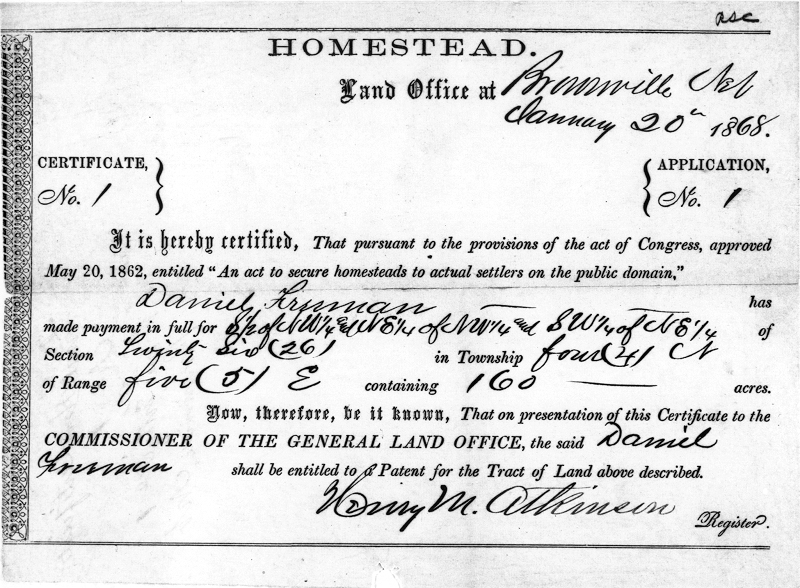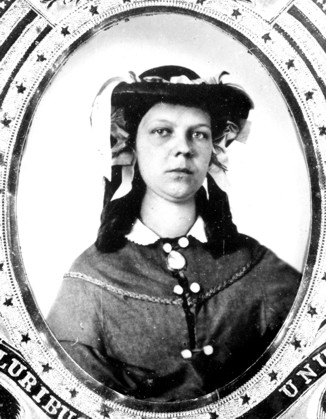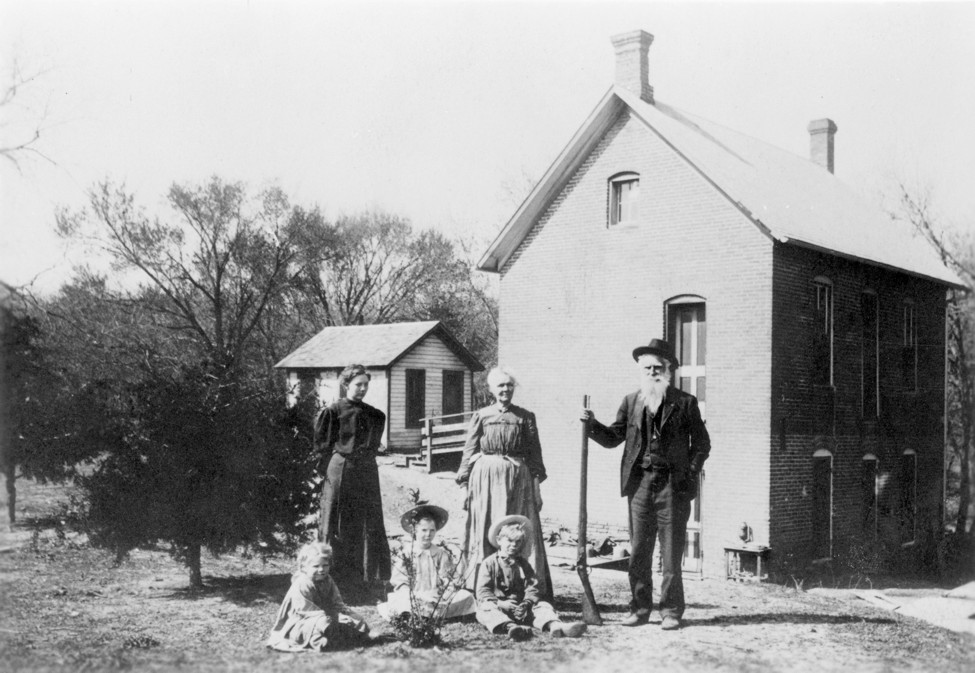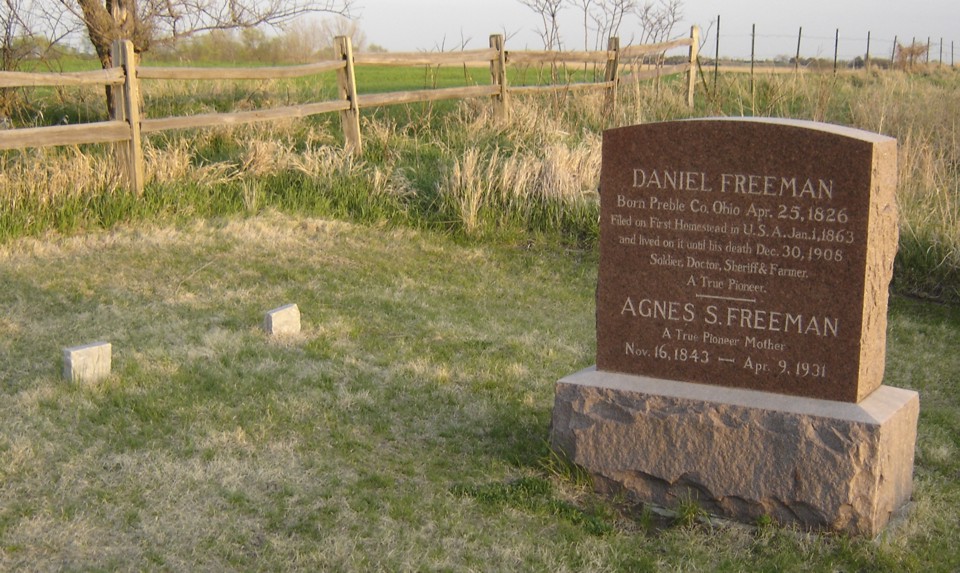|
What is a primary
source document?
When historians want to know about an event in the past, they especially like to find what are called primary source documents. These include eyewitness accounts of the event, diary entries by people who were there, legal papers connected with the event, photos of the event, and that sort of thing. An online article or library book about a past event, written by someone who wasn't there, is called a secondary source. The document below is a primary source document. As you can see, it is a land ownership certificate related to the Homestead Act. That law was passed by Congress during the Civil War. It was meant to encourage settlement of the West by giving 160 acres of government-owned land to anyone willing to move there, build a house, and stay for five years. Only a small fee was required to make an official record of the land ownership. Look over this document carefully, and then continue reading to learn more about the remarkable story behind it. |

Daniel Freeman, about 78 years old, and about 40 years after moving with his wife to Nebraska. |
First, find the
facts in this
primary source document! 1. What is the date on the land ownership certificate shown above, which was issued to Daniel Freeman in Brownville, Nebraska? 2. What was the application number? (Freeman was, in fact, the first person to fill out an application under the Homestead Act - on January 1, 1863.) 3. The document makes a reference to the date when the Homestead Act itself was passed by Congress. What was that year? 4. From the wording on this document, does it appear the Homestead Act gave land to anyone who wanted it, or only to people who would actually go settle on the land? 5. How many acres of land was Daniel Freeman given, according to this document? When Daniel Freeman filled out his original application in 1863, he selected land near Beatrice, Nebraska. His certificate of ownership for that land is dated 1868, after he completed the Homestead Act's requirement of living there for five years. |
 A war, a death, a
new A war, a death, a
new love, and a new life together Daniel Freeman was a physician and a widower living in Illinois when he joined the Union Army during the Civil War. He was assigned to patrol duty in Nebraska at one point. While serving there, he built a cabin on unclaimed land a few miles from the town of Beatrice. That was the plot of land he wanted to gain ownership of when he filled out his Homestead Act application in 1863. Daniel's much younger brother James also joined the Union Army, and was engaged to a school teacher in Iowa named Agnes Suiter. James, however, died of an illness early in the war. Over the next few years Daniel and Agnes wrote each other many letters. In one of them Daniel declared: "I love you and would be happy in trying to make you happy if you can love me in return. I would like to make you Mrs. Freeman. . . if this does not suit you, pardon me for writing it. I know you will, for no lady can blame a man for loving her even if she cannot love him in return." After some more heartfelt letters back and forth, Agnes agreed to become Daniel's wife. In 1865 they were married in her parents' home in Le Claire, Iowa. She later recalled their wedding day: "I had made me an awful pretty gray dress, all trimmed with lace and beads; but my mother thought a girl ought to be married in silk - an old fashioned idea of course. I had a pretty black silk, so I was married in that. There were no guests at the wedding, just the family. We had a nice supper. In a couple of days we went to Abington to visit his folks. When we got back to Eddyville, where he had left the wagon, we put a canvas cover on it and started for Beatrice." Beatrice was the town in Nebraska close to where Daniel had his Homestead Act farm land. Agnes always remembered the night they arrived at the log cabin he had built there: "A big fireplace brought forth warmth, and though one was only half length, there was a window on each side of the cabin. There was a chair and two oak benches. The bed was built in the wall, and the mattress was filled with hay. A small oil lamp with none too polished chimney, flickered dimly on the table. I was tired from my journey and as I got warm and rested it seemed more and more like home, and though often afterwards, I longed to go back east, this has been home to me ever since." Read All About It: Agnes' memories quoted above are taken from a newspaper interview in 1925, 60 years after her marriage. At that time, she was 81 years old and a widow. You can read the published story, with her memories of life with Daniel and their eight children, by clicking here. Her last name is misspelled "Suitor" in the article. Agnes died in 1931. The National Park Service later purchased the land from the couple's children. It became the Homestead National Monument of America. The photo of Agnes above is from their collection of historical materials. The NPS has a web site with more about the farm and the family, including some of the letters between Daniel and Agnes. Click here to explore it. |
The photo below shows the Freeman farm about 20 years after
they moved there. The couple had eight children.
photo credit: Homestead National
Monument of America
Daniel and Agnes lived in a log cabin as they began their family together, but
later had a small brick house constructed. The photo below shows them as an elderly
couple on their farm with one of their daughters and three of their grandchildren.

photo credit: Homestead National Monument of America
The photo below shows the burial site of Agnes and Daniel Freeman on the land they farmed.
The two small headstones mark their graves. The larger stone marker was added later.

The land certificate image is from the National Archives.
The photo of Daniel Freeman is from the Library of Congress.
The photos of Agnes Freeman, the Freeman farm, and the brick house are
from the Homestead National Monument of America.
The grave site photo is a public domain image courtesy of
Wikipedia photo contributor "Billdorr."
Some images have been edited or resized for this page.
Quotes from the letters of Daniel and Agnes Freeman and
the 1925 newspaper interview with Agnes have been
slightly edited for spelling and clarity.
The original sources are linked above.
|
Copyright Notice
Copyright 2009, 2021 by David Burns. All rights reserved. As a guide to the Virginia Standards of Learning, some pages necessarily include phrases or sentences from that document, which is available online from the Virginia Department of Education. The author's copyright extends to the original text and graphics, unique design and layout, and related material. |